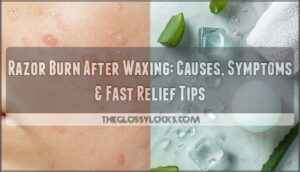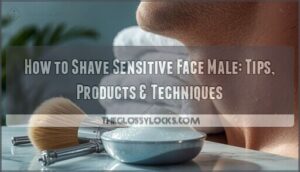This site is supported by our readers. We may earn a commission, at no cost to you, if you purchase through links.

The good news? A few evidence-based habits—ones that cost almost nothing and take minutes—can transform stubborn, rough skin into the smooth legs you want. It starts with understanding what your skin actually needs, not what marketing tells you to buy.
Table Of Contents
- Key Takeaways
- Exfoliation Techniques for Smoother Legs
- Shaving and Hair Removal Tips
- Hydration and Moisturizing Essentials
- Preventing and Treating Skin Irritation
- Pro Tips for Enhanced Leg Smoothness
- Frequently Asked Questions (FAQs)
- How do you get smooth legs?
- Do your legs look smooth?
- How do I keep my legs soft and smooth year-round?
- Are silky smooth legs good for summer?
- How to get silky smooth legs?
- How do I make my legs look perfect?
- What causes bumps on the back of thighs?
- How do I soften rough knee skin?
- Can diet affect leg skin texture and appearance?
- What causes skin discoloration or dark patches?
- Conclusion
Key Takeaways
- Smooth legs require a consistent three-step approach combining regular exfoliation (1-2 times weekly) to remove dead skin cells, proper shaving technique with the grain using sharp blades, and immediate moisturizing within three minutes after showering while skin is still damp to lock in hydration.
- Chemical exfoliants like AHAs and BHAs are gentler and more effective than physical scrubs for most skin types, dissolving dead cell bonds over 4-6 weeks rather than mechanically abrading the surface, which reduces irritation while improving skin texture and product absorption.
- Hot water strips away natural oils and compromises your skin barrier, so keep showers lukewarm (5-10 minutes max) and always follow with moisturizer application on damp skin to prevent dryness and maintain the smoothness you’ve worked to achieve.
- Internal hydration matters as much as topical care—drinking eight glasses of water daily, consuming omega-3s, and managing stress all support skin health from within, making your external skincare routine significantly more effective at maintaining soft, smooth legs year-round.
Exfoliation Techniques for Smoother Legs
Exfoliation is your first line of defense against rough, dull skin on your legs. The right technique sloughs off dead cells, reveals fresh skin underneath, and creates the perfect canvas for moisturizers to actually do their job.
Let’s look at the methods that work best and how to use them without irritating your skin.
Body Scrubs and Loofahs
If you want legs that feel like silk, your best friends are body scrubs and loofahs—simple tools that sweep away dead skin cells and reveal the smoother skin underneath. Here’s how to make exfoliating the skin work for you:
- Choose gentle scrubs with natural ingredients like sugar or oat-based formulas that won’t irritate
- Use your loofah in circular motions to boost skin texture and circulation
- Pick hydrating exfoliant types that cleanse without stripping moisture
- Focus on rough patches like knees where dead cells build up most
- Apply your body scrub to damp skin using smoothing techniques that feel like a mini-massage
This simple routine delivers noticeably smooth skin.
Dry Brushing Best Practices
Dry brushing takes exfoliation a step further by using stiff bristles on bare skin before you even step into the shower. Start at your feet and work upward in small circular motions—this brushing technique boosts circulation while sloughing off dry skin.
Make it part of your daily routine for consistent exfoliation benefits and noticeable skin stimulation. Just remember: don’t exfoliate with scrubs or chemical products the same day you dry brush, or you’ll risk irritation instead of smooth skin.
Chemical Vs. Physical Exfoliants
Beyond brushes and scrubs, you’ve got two main exfoliation routes: physical and chemical. Physical exfoliants use mechanical abrasion—think scrub particles or bristles—to sweep away dead cells instantly. Chemical exfoliants like AHAs and BHAs dissolve the bonds holding those cells together, delivering smoother skin texture over four to six weeks.
Both improve product absorption and address concerns from rough patches to mild acne, but chemical formulations now dominate the market due to their gentler action mechanism and clinical benefits for sensitive skin types. Understanding the difference between physical and chemical methods is key to choosing the right exfoliation techniques for your skin.
How Often to Exfoliate
Once you know which type works for your skin, the next question is timing—and the answer depends on your legs’ tolerance and your chosen method.
Exfoliate one to two times weekly using a scrub or loofah—that’s enough to remove dead cells without stripping your skin barrier.
Daily dry brushing works well for gentle exfoliation, just don’t combine it with chemical exfoliants on the same day.
Shaving and Hair Removal Tips
Getting a close, smooth shave without the irritation isn’t as tricky as it seems—you just need the right approach. From prepping your skin properly to picking tools that work with your body, not against it, these strategies make a real difference.
Let’s walk through what actually works with hair removal for your legs.
Prepping Legs for Shaving
The secret to a buttery-smooth shave isn’t the razor itself—it’s what you do in the minutes leading up to it.
Start your pre-shave routine by soaking legs for 15–20 minutes in the tub or spending at least 3 minutes in the shower. This skin preparation softens both hair and skin, making shaving with the grain much easier.
Exfoliate first to clear away dead cells that could cause razor burn, then you’re shave-ready for a truly smooth skin finish.
Choosing The Right Razor
Your razor isn’t just a tool—it’s your partner in achieving irritation-free, smooth skin every time you shave. Look for safety features like hydrating strips and multiple blade options that glide smoothly without tugging.
A comfortable razor grip gives you better control, while sharp blades prevent nicks and razor burn. Change your razor head every 5–7 shaves—dull blades cause more irritation than they prevent.
Pair it with quality shaving creams for the best results.
Shaving Techniques to Prevent Irritation
Shaving the right way means following a few simple moves that keep your skin calm, smooth, and free from those red bumps that ruin the whole point.
Always shave in the direction of hair growth—going against it invites razor burn and ingrown hairs. Apply shave gels generously for glide, rinse your razor after every few strokes, and finish with cool water to close pores.
Pat dry gently, then follow up with post-shave care using a fragrance-free moisturizer to lock in hydration and prevent irritation.
Alternatives: Waxing, Creams, and Laser
If you’re ready to step beyond the razor, waxing benefits include longer-lasting smoothness—usually four to five weeks between sessions—as hair removal methods targeting the root lead to finer regrowth over time.
Depilatory creams dissolve hair at the surface using thioglycolate, though they carry a 15% risk of contact dermatitis on legs.
Laser hair removal delivers 70–90% hair reduction after six to eight sessions, making it the most effective choice for lasting leg hair removal despite higher upfront costs. Considering the long-term effects, opting for laser hair removal treatment can be a cost-effective solution.
Hydration and Moisturizing Essentials
You’ve exfoliated and shaved—now it’s time to lock in that smoothness with proper hydration.
Moisturizing isn’t just about slapping on lotion; it’s about timing, choosing the right products, and understanding how your skin actually retains moisture.
Here’s what you need to know to keep your legs feeling soft and looking healthy.
Applying Moisturizer After Showering
Right after you step out of the shower—while your skin’s still damp and warm—is the golden window for locking in moisture. You’ve got about three minutes before that window closes, so don’t waste time. Pat yourself dry gently, then slather on your body moisturizer. This simple step makes all the difference in keeping your legs hydrated and smooth.
Key moisturizer benefits to remember:
- Applying moisturizer on damp skin traps water beneath the surface, boosting skin hydration far better than waiting until you’re completely dry
- Moisturizing daily strengthens your skin’s natural barrier, protecting against dryness and environmental damage throughout the day
- Using a hydrating body wash beforehand preps your skin to absorb moisture more effectively, creating the perfect canvas for after shower care
- Making this part of your daily routine takes less than a minute but yields benefits you’ll feel all day long
- Consistency with locking moisture post-shower transforms rough, flaky legs into soft, touchable skin within weeks
Choosing The Best Lotion or Oil
Not all moisturizers work the same magic on your legs—picking the right formula for your skin type can mean the difference between fleeting softness and all-day smoothness. Body lotion works beautifully in warmer weather, while rich body oil or cream addresses dryness head-on during colder months.
| Skin Type | Best Moisturizer Choice |
|---|---|
| Dry | Thick body cream or nourishing oil benefits with shea butter |
| Normal | Lightweight body lotion with hydrating ingredients |
| Oily | Oil-free lotion that won’t clog pores |
| Sensitive | Fragrance-free formulas with minimal lotion ingredients |
| Combination | Layer body oil under lotion for targeted hydration tips |
Match your natural moisturizers to what your skin actually needs, and you’ll notice the difference immediately.
Locking in Moisture for Lasting Smoothness
The real trick isn’t just slathering on lotion—it’s applying it at the right moment and sealing everything in before moisture escapes. Pat your legs dry gently after showering—don’t rub—then apply your moisturizing lotion within three minutes while skin’s still damp.
This daily moisturizing habit locks in skin hydration and boosts moisture retention. For extra smooth skin secrets, layer body oil under cream for double the hydration tips.
Importance of Drinking Water
While topical hydration works wonders on the outside, what you drink matters just as much—your skin cells need water from the inside out to stay plump and supple. Aim for eight glasses daily to support fluid balance and improve skin hydration.
Proper water intake boosts daily moisture from within, helping your moisturizing routine work better. Think of it as fueling healthy skin—hydration starts at the cellular level before any lotion touches your legs.
Preventing and Treating Skin Irritation
Smooth legs are great, but irritation can quickly ruin your results. The good news is that most skin problems—from razor burn to dryness—are totally preventable with a few smart habits.
Let’s cover the most common issues and how to manage them.
Avoiding Razor Burn and Ingrown Hairs
You’ll dodge most razor burn and ingrown hairs by shaving with the grain—meaning in the direction of hair growth—rather than against it. This razor burn prevention technique cuts down irritation by up to 60% in clinical settings.
For ingrown hair treatment, exfoliate two to three times weekly using skin exfoliation methods like chemical exfoliants containing salicylic acid, which unblock follicles.
Sharp, clean razors paired with proper shaving techniques and post-shave care using alcohol-free moisturizers keep your smooth legs free from bumps and redness.
Protecting Skin With Sunscreen
Even when you’ve nailed your shaving routine, sun damage can undo all that work—which is why sunscreen on your legs matters just as much as it does on your face.
UV protection isn’t negotiable if you want healthy, smooth skin long-term. Apply broad-spectrum SPF 30 or higher daily when your legs are exposed—this simple step prevents premature aging, rough texture, and reduces skin cancer risk while fitting perfectly into your summer skincare routine.
Soothing Sensitive or Dry Areas
Some areas of your legs—like shins, knees, and ankles—seem to attract dryness and sensitivity no matter how careful you’re with your routine. These zones have thinner skin and fewer oil glands, making them prone to irritation and razor burn.
Focus your moisturizing techniques here with thicker creams or healing ointments like shea butter, and skip aggressive exfoliating on already-irritated spots to support skin barrier repair.
When to Consult a Dermatologist
Most home remedies manage minor bumps and dryness, but persistent rashes, changing moles, or non-improving irritation after two weeks signal it’s time to consult a dermatologist.
Chronic conditions like keratosis pilaris, spreading rashes covering large areas, or any skin concerns involving blistering, oozing, or fever need professional evaluation—your primary care doctor can help determine if specialist care is warranted for stubborn skin irritation.
Pro Tips for Enhanced Leg Smoothness
You’ve already covered the basics of getting smooth legs, but there are a few extra strategies that can take your results to the next level.
These finishing touches address everything from appearance to circulation and overall skin health. Here’s what can make a real difference in how your legs look and feel.
Using Self-Tanner for an Even Glow
Self-tanner can give your legs a smoother, more polished look by evening out your skin tone and adding a subtle glow—no sun damage required.
Before applying self-tanner, prep your skin by exfoliating and moisturizing dry areas like knees and ankles to prevent streaks. Choose a mousse for natural results, lotion for gradual color, or mist for that airbrushed finish.
This simple addition to your summer skincare routine helps you achieve a sun-kissed glow while making your smooth legs look even more radiant.
Bathing and Shower Temperature Advice
Hot showers might feel incredible, but they’re actually working against your goal of smooth, soft legs. High water temperature strips away your skin’s natural oils, leaving it dry and rough. Taking cooler showers helps preserve your skin barrier and maintain better skin hydration.
Here’s how to improve your bathing routine:
- Keep water temperature lukewarm or moderate — hot water disrupts skin pH and dries you out
- Limit shower duration to 5-10 minutes — extended exposure increases moisture loss
- Adjust bathing frequency based on your skin type — daily bathing isn’t always necessary
- Soak for 15-20 minutes before shaving — this softens hair and improves your shave
- Moisturize immediately after — apply lotion within 3 minutes while skin’s still damp
Lifestyle Habits for Healthier Skin
What you put into your body matters just as much as what you put on it—your daily habits shape your skin’s health from the inside out. Drink eight glasses of water daily for improving skin hydration. A diet rich in omega-3s promotes dietary skin care—consider fish oil supplements.
Quality sleep patterns help skin repair itself. Stress management reduces inflammation that triggers dryness.
Maintaining healthy skin requires consistency: stick to your skin care routine with regular exfoliating and moisturizing for lasting results.
Boosting Circulation With Massage or Body Brushing
Improving blood flow to your legs isn’t just about reducing puffiness—it actually brings oxygen-rich blood to the skin’s surface, creating that healthy, glowing appearance you’re after.
Body brushing and massage techniques work as powerful circulation boosters:
- Dry brushing daily before showering stimulates skin exfoliation while enhancing blood flow.
- Use small circular motions with your body brush, starting at your feet and moving upward.
- Massage olive oil into legs before bed for skin stimulation and moisture.
- Focus on rougher areas like knees where circulation needs the most attention.
Frequently Asked Questions (FAQs)
How do you get smooth legs?
Getting smooth legs feels ironic—you’d think something so simple wouldn’t need strategy.
Combine regular exfoliating, smart shaving techniques, and moisturizing right after your shower for silky skin secrets that actually work.
Do your legs look smooth?
Your legs can look smooth when you consistently exfoliate to support cell removal, shave with proper techniques, and apply moisturizing products that improve skin texture.
Regular leg care creates silky legs through achieving smooth skin with skin exfoliation and hydration.
How do I keep my legs soft and smooth year-round?
Consistency is your best friend for maintaining smooth legs throughout the year. Stick to a skin care routine that includes regular skin exfoliation, daily moisturizing after showering, and proper shaving techniques.
Use gentle products suited to your skin type, protect with sun protection outdoors, and support your skincare efforts with a healthy lifestyle.
Are silky smooth legs good for summer?
Absolutely—silky smooth legs are perfect for summer. Shorts, skirts, and swimsuits all showcase your skin, so exfoliation, moisturizing, and shaving techniques help you feel confident.
Plus, summer skin care protects against sun damage while boosting that warm weather glow.
How to get silky smooth legs?
You’ll achieve silky legs through consistent exfoliation to smooth skin texture, proper shaving techniques, and immediate moisturizing after showering.
This beauty routine combines leg care basics—removing dead cells, gentle hair removal, and locking in hydration—for lasting smooth skin results.
How do I make my legs look perfect?
The proof is in the pudding—your Leg Care Routine makes all the difference. Start with Exfoliating leg skin, then use proper Shaving techniques for smooth legs.
Follow with Moisturizing leg skin to improve Skin Texture Improvement. These Smooth Leg Secrets create a Perfect Leg Appearance through consistent Perfect Leg Tips for achieving smooth legs.
What causes bumps on the back of thighs?
Bumps on your thighs are often keratosis pilaris—trapped keratin creating rough skin texture. Folliculitis causes inflammation from irritated follicles, while razor bumps and ingrown hairs trigger skin irritation after shaving.
Dry skin worsens these conditions, making regular exfoliation essential for bump prevention.
How do I soften rough knee skin?
Knees take a beating—literally—which is why they often feel like sandpaper. Focus your exfoliating efforts on these rough patches using a granular scrub or loofah, then follow up with a thick moisturizer or body butter to lock in hydration and restore skin softness.
Can diet affect leg skin texture and appearance?
Yes—nutrient intake directly influences skin health. Omega benefits include improved hydration levels and skin texture. Food allergies can trigger inflammation affecting skin appearance.
Skin supplements and proper hydration levels support overall skin care from within.
What causes skin discoloration or dark patches?
Skin discoloration happens when melanin production goes haywire—triggered by sun damage, hormonal shifts, inflammation from shaving or ingrown hairs, or conditions like post-inflammatory hyperpigmentation.
Your skin barrier plays a huge role in protecting your natural skin tone and radiance.
Conclusion
Think of your skin like a garden—it thrives when you work with its natural rhythms, not against them. These easy tips for smooth legs aren’t about flawlessness; they’re about consistency.
Exfoliate when dead cells accumulate, shave with intention instead of speed, and lock in moisture while your skin’s still damp. Skip the hot showers that strip your barrier, and remember: smoothness isn’t a product you buy once.
It’s a practice you polish. Your legs will reflect the care you invest, one simple step at a time.
- https://www.youthtothepeople.com/hand-body/10%25-aha-yerba-mate-smoothing-energy-body-scrub/YTTP-70500.html
- https://www.aad.org/public/diseases/a-z/dry-skin-self-care
- https://www.skinceuticals.com/skincare-advice/physical-vs-chemical-exfoliation.html
- https://skincarejunkie.com/blogs/news/derm-s-guide-to-face-skin-exfoliation
- https://www.grandviewresearch.com/industry-analysis/exfoliators-market-report











